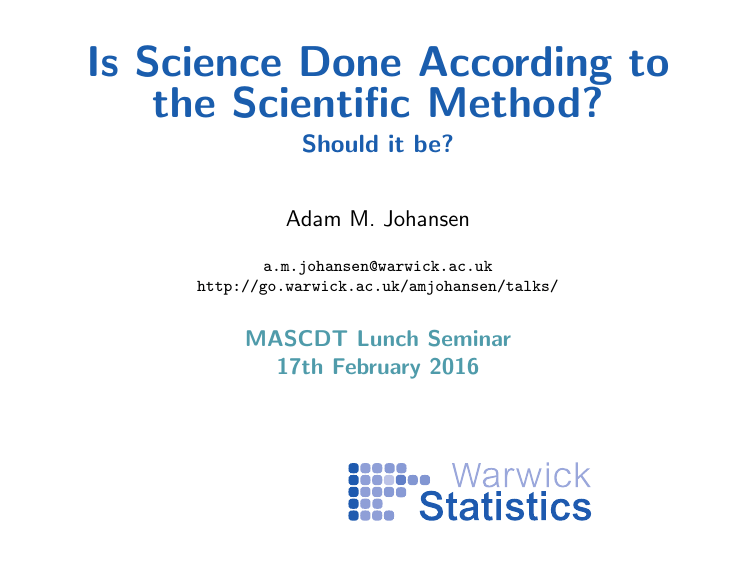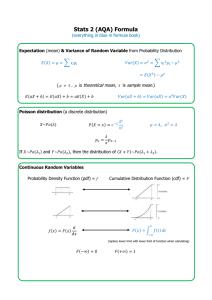Is Science Done According to the Scientific Method? Should it be?
advertisement

Is Science Done According to the Scientific Method? Should it be? Adam M. Johansen a.m.johansen@warwick.ac.uk http://go.warwick.ac.uk/amjohansen/talks/ MASCDT Lunch Seminar 17th February 2016 Context: The “Reproducibility Crisis” Increasingly, published findings cannot be reproduced: I Ioannidis, John PA. “Why most published research findings are false.” PLoS Medicine 2.8 (2005). I Vul, Edward, et al. “Puzzlingly high correlations in fMRI studies of emotion, personality, and social cognition.” Perspectives on psychological science 4.3 (2009): 274-290. I Open Science Collaboration. “Estimating the reproducibility of psychological science.” Science 349.6251 (2015). Superficial mitigation: I Explicit description of all relevant (whatever that means) details. I Including experimental conditions, data preprocessing and analysis. I Making data and code available. are good things, but not a solution. 2/16 Source: https://commons.wikimedia.org/wiki/File:The_Scientific_Method_as_an_Ongoing_Process.svg 3/16 Hypothesis Testing I Given two hypotheses: H0 The universe is as we thought, e.g. θ = 0. H1 The universe more complicated in some specified sense, e.g .θ 6= 0. I gather some data, x ? , I and compute some statistic, T (x ? ). I Compute p = P(T (X ) at least as extreme as T (x ? )|H0 ). I If p < α reject H0 at signifance level α. 4/16 Issue 1: Multiple Testing / Selective Reporting If tests are carried out between H0 and H1 , . . . , Hn then the significance level is different to their individual levels. Multiple Groups Lots of research groups around the world are trying to answer the same questions. Selective Publication Only significant findings are normally published. Data Mining https://xkcd.com/882/ Jelly Beans aren’t associated with acne; nor are purple, brown, blue, teal, salmon, red, turqoise, magenta, yellow, grey, tan,. . . jelly beans. But green jelly beans are. Genuine Multiple Testing GWAS, Neuroimaging,. . . Some partial solutions: registration of studies; publication of negative results; controlling false discovery rate (reduces power). 5/16 Interpreting p values Clearly if p 1 then there is strong evidence to reject H0 . I Consider this experiment: H0 X1 , . . . , Xn are samples from a normal population of mean 0 and variance 1. H1 X1 , . . . , Xn are samples from a normal population of mean 0.001 and variance 1. I We observe T = 14 (X1 , . . . , X4 ) = 7.124 I p = P(T ≥ 7.124|H0 true) = 1.0018 × 10−46 I P(T ≥ 7.124|H1 true) = 1.0308 × 10−46 . I Age of the universe: 4.35 × 1017 s. Perhaps its not so clear. I We’d need n 106 to distinguish between H0 and H1 . I p 1 means: the null model doesn’t describe the data; if the alternative doesn’t either that’s not very informative. 6/16 Interpreting p values Clearly if p 1 then there is strong evidence to reject H0 . I Consider this experiment: H0 X1 , . . . , Xn are samples from a normal population of mean 0 and variance 1. H1 X1 , . . . , Xn are samples from a normal population of mean 0.001 and variance 1. I We observe T = 14 (X1 , . . . , X4 ) = 7.124 I p = P(T ≥ 7.124|H0 true) = 1.0018 × 10−46 I P(T ≥ 7.124|H1 true) = 1.0308 × 10−46 . I Age of the universe: 4.35 × 1017 s. Perhaps its not so clear. I We’d need n 106 to distinguish between H0 and H1 . I p 1 means: the null model doesn’t describe the data; if the alternative doesn’t either that’s not very informative. 7/16 Interpreting p values Clearly if p 1 then there is strong evidence to reject H0 . I Consider this experiment: H0 X1 , . . . , Xn are samples from a normal population of mean 0 and variance 1. H1 X1 , . . . , Xn are samples from a normal population of mean 0.001 and variance 1. I We observe T = 14 (X1 , . . . , X4 ) = 7.124 I p = P(T ≥ 7.124|H0 true) = 1.0018 × 10−46 I P(T ≥ 7.124|H1 true) = 1.0308 × 10−46 . I Age of the universe: 4.35 × 1017 s. Perhaps its not so clear. I We’d need n 106 to distinguish between H0 and H1 . I p 1 means: the null model doesn’t describe the data; if the alternative doesn’t either that’s not very informative. 8/16 Some More Context From a (published psychology) paper considering the 2012 US Presidential Election: Ovulation led single women to become more liberal, less religious and more likely to vote for Barack Obama. In contrast, ovulation led married women to become more conservative, more religious and more likely to vote for Mitt Romney. Findings: I Were statistically significant. I Had an associated effect size of around 20% (!). I Were wildly at odds with existing evidence that any such effect could plausibly be at most ∼ 2%. The innocent shall remain anonymous to protect the guilty. 9/16 Issue 2: Testing without Power H0 T is normally distributed with mean µ = 0 and standard deviation 8.1. 0.05 probability density 0.04 0.03 0.02 0.01 0.00 −35 −30 −25 −20 −15 −10 −5 02 5 10 15 20 25 30 35 H1 T is normally distributed with mean µ 6= 0 and standard deviation 8.1. P(Reject H0 |µ = 0) = 0.05 True µ = 2 P(Reject H0 |µ = 2) ≈ 0.06 P(T < 0|µ = 2, reject) ≈ 0.24 P(|T | > 16|µ = 2, reject) = 1 Small studies of small effects. . . effect size 10/16 Consequences of Under-powered tests If power is small1 then: I Significant effects are roughly equally probably under null and alternative hypotheses. I Effect size is exaggerated whenever it’s significant non-zero. I Effect sign could be wrong even when it’s significantly non-zero. So, if we: I Carry out many independent tests, I determine which produce significant findings, I report those which are. . . the results are unlikely to be what was intended. 1 Usually the case for small effects, moderate sample sizes and especially multiple testing. 11/16 The Bonferroni principle I Consider carrying out a large number, m, of tests. I We expect αm false positives by chance. I If there are k real effects to find, and the power of each associated test is βi for i = 1, . . . , k, we’ll find about β1 + . . . + βk of them. I Of the significant findings, a proportion β1 + . . . + βk /(αm + β1 + . . . + βk ) of them will be real. I “If the number of true positives is small compared to the expected number of false positives, then you won’t find anything useful.” 12/16 Issue 3: The Cox-Jaynes Axioms and Bayesian Inference I Approximately, if degrees of belief: 1. Can be represented with Real Numbers; 2. show a qualitative corresponds with common sense; 3. and exhibit internal self-consistency, then: I they behave as probabilities; I in light of new data they must be updated using Bayes rule; Naı̈ve combination of p values violates this principle. 13/16 Issue 3: The Cox-Jaynes Axioms and Bayesian Inference II Three formal axioms: 1. Degrees of belief obey a transitive order relationship, i.e.: B(x) > B(y ) and B(y ) > B(z) ⇒ B(x) > B(z) (1) This allows degrees of belief to be mapped to real numbers. 2. There exists a relationship between the degree of belief in any proposition, x and that in its negation, ¬x: ∃f such that f [B(¬x)] = B(x) (2) 3. The degree of belief in the conjunction of two propositions, x and y is related to the degree of belief in the conditional proposition x|y and the degree of belief in the proposition y : ∃g such that B(x, y ) = g [B(x|y ), B(y )] (3) 14/16 Bayesian Inference in One Slide I Data y1 , . . . , yn and data model f (y1 , . . . , yn |θ) where θ is some parameter of interest. I In the frequentist framework θ is a parameter, not a random variable. I In the Bayesian framework θ is a random variable with prior distribution f prior (θ). After observing y1 , . . . , yn the posterior density of f is f post (θ) = f (θ|y1 , . . . , yn ) f prior (θ)f (y1 , . . . , yn |θ) = R prior (ϑ)f (y1 , . . . , yn |ϑ) dϑ Θf ∝ f prior (θ)f (y1 , . . . , yn |θ) I But what is f prior ? Can it be specified objectively? 15/16 Some Questions I Have many recent studies deviated from the scientific method? I Or does the method itself need revising to be suitable for modern science? I How useful are testing and p-values obtained from single studies? I Is registration of studies a good idea? I Was The Journal of Basic and Applied Social Psychology right to ban “null hypothesis testing and p values” in 2015? I Might Bayesian approaches be useful in this context? I How can we reconcile prior distibutions with science? I Is absolute objectivity possible? I Is objectivity or transparency more important? I What’s the solution to the reproducibility crisis? 16/16




